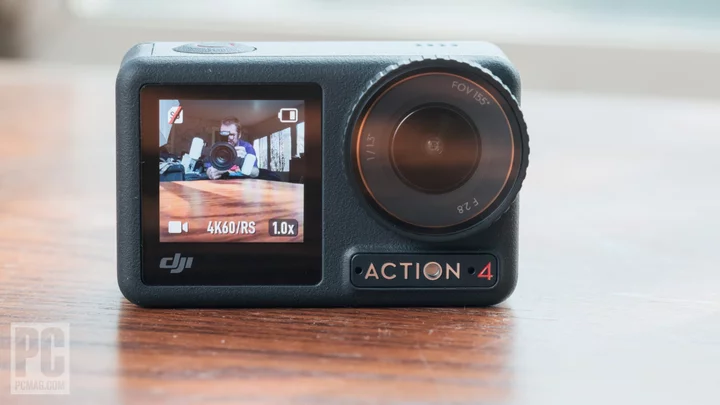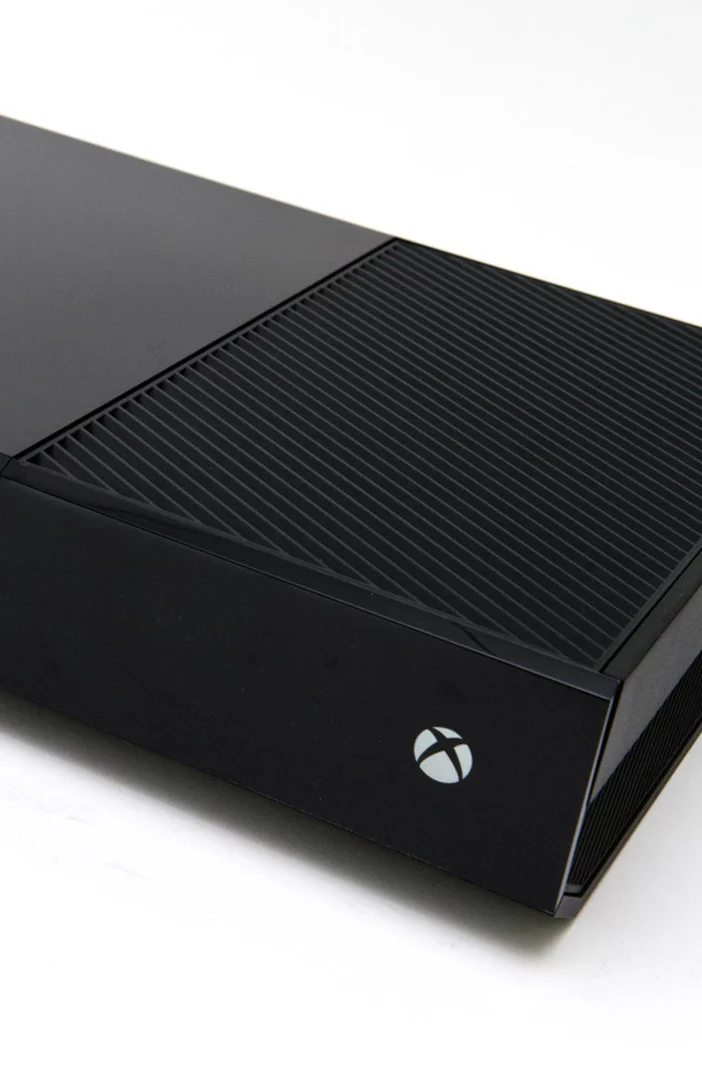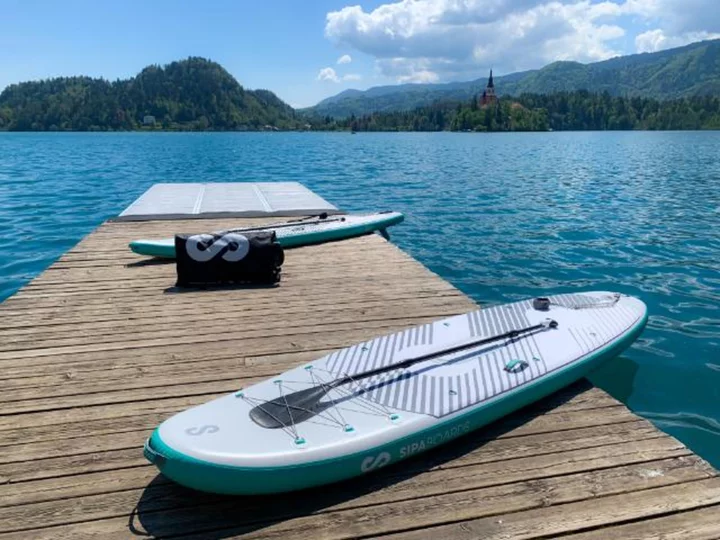The DJI Osmo Action 4 ($399) makes a good argument for buying an action camera that's not a GoPro. Like the GoPro Hero11 Black ($399.99), it offers a tough, waterproof build and has a color front screen, but it does a notably better job in dim light and lasts longer per charge. The GoPro remains our overall Editors’ Choice winner because of its more versatile sensor aspect ratios and 2.7K240 slow-mo, though you shouldn’t count out the Osmo if you prefer everyday vlogging to capturing action sports.
DJI's GoPro Clone
There's no question as to where DJI drew its inspiration for the Osmo Action series. The Action 4 is a near clone of the original model, which itself is a copy of early entries from the GoPro Hero series. DJI did bring innovation to the category, however; it put a color screen on the front of its camera first, a feature GoPro later copied. Imitation goes both ways.
The consistency in design isn't surprising: Action cams all strive to be easily mountable in tight spaces and include enough room for a touch screen and oversized buttons. And it's not like DJI didn't try something else: The Action 2 featured a quirky modular magnetic design, for instance. It clearly wasn't successful though because the company went right back to the traditional body style for the Action 3.
Left to right: GoPro Hero11 Black, DJI Osmo Action 4 (Credit: Jim Fisher)The Action 4 is a small rectangular brick that has a lens and color screen on the front, as well as another color screen on the back. Like other small action cams, its small form and ultra-wide lens make it ideal for mounting. The camera measures 1.7 by 2.8 by 1.3 inches (HWD) and weighs about 5.1 ounces, not far off from the GoPro Hero11 Black (2.0 by 2.8 by 1.3 inches, 4.5 ounces).
The Osmo relies on a removable, magnetic mounting clip, whereas the GoPro integrates its mount points into its body. Both methods have their merits. With the GoPro, you don't have to hunt around for the mount when you need it. But with the Osmo, you can keep a couple of mounting clips around and move the camera between them quickly. Just take care not to forget your Osmo mount at home or lose it, as replacements cost $15.
A magnetic quick release plate clamps into the notches on the bottom of the Osmo 4 (Credit: Jim Fisher)The Action 4's metal frame and waterproof design mean you don't have to worry too much about hurting the camera if you're using it for extreme sports or other risky activities. It can survive at depths of 59 feet (18m) without a case, which beats the 33-foot rating of the Hero11.
The basic Osmo bundle includes the camera, a battery, a USB-C cable, a couple of sticky mounting pads, a magnetic mounting base, and a cage with a side mount for vertical filming. If you prefer to have some spare batteries, it's worth stepping up to the $499 Adventure Combo. That option bundles three batteries instead of one, a charging and storage case to hold the extra batteries, and a handy 5-foot (1.5m) extension rod.
The $499 Adventure Combo includes three batteries and a charging case (Credit: Jim Fisher)DJI also sells a host of accessories for the Osmo, including a set of ND filters for $59, the wireless DJI Mic for $320, a mini extension rod with a built-in mounting point and tripod feet for $49, and a handlebar mount for $39. GoPro mounting accessories work, too.
Osmo Action 4 Interface and Controls
The Osmo's controls are fairly bare-bones, but give you all the options you need. There are two physical buttons: a Record button on top and a Quick Shift mode button on the left side. Both the front and rear screen support touch input and you can use voice commands to start and stop recording—a plus if you're wearing gloves or can't easily reach the camera.
(Credit: Jim Fisher)A wrist-worn Bluetooth remote accessory is available for $79 if you want more control when you can't reach the camera. It includes GPS capabilities so you can geotag pictures and video.
The 2-inch touch screen intuitively shows icons that double as touch buttons. You see a Movie camera icon in video mode, for example, and can swap to the photo or time-lapse mode just by tapping on it. Likewise, it takes just a quick tap to change the resolution and frame rate settings that appear at the bottom of the screen.
I ran into problems with the rear screen when viewing it through a pair of polarized sunglasses though. The display went dark when I held the camera in landscape for 16:9 recording, though I could see it fine for vertical video. The front screen does better here, as it's viewable both ways through polarized lenses.
(Credit: Jim Fisher)The interface is clean, but not quite as powerful as GoPro's. For instance, whereas the GoPro allows you to save a few presets with frame rate, color, and resolution options, the Osmo simply remembers your most recent settings. On the other hand, I love that DJI lets you restrict what modes the camera cycles through when you press the Quick Shift button, an option missing from the GoPro. I still give preference to the GoPro overall, however, as the presets are quite useful.
The front screen isn't just for monitoring; it also works for quick settings changes. This is convenient for anyone who typically self-records because it means you can adjust settings without getting behind the camera. The display is small, however, so it's not quite as easy to navigate as the larger rear screen. One thing to note—if you're using the camera at 60fps or higher, only one of the screens is active during recording. Just tap on the one you want to use if it's blank to switch to it.
Osmo Action 4 Power and Connectivity
The Action 4 does a better job of managing heat than the Hero11 and I got 78 minutes of continuous 4K60 recording on a fully charged battery without any issues. This test made the camera warm to the touch, but not hot. For comparison, the Hero11 Black overheats after around 25 minutes of 5.3K60 in similar conditions and gets just an hour of power from its Enduro battery. Just keep in mind that both cameras can overheat if you're working in warmer environments; I got about 25 minutes of 4K60 from the Osmo before it started throwing heat warnings outdoors on a sunny, 80-degree day.
The Osmo is short on physical ports—the only one of note is a USB-C connection to plug in an external mic, transfer data, and charge the battery. A locking door protects that port to ensure waterproofing. Wi-Fi and Bluetooth are also available, and the camera connects to the DJI Mimo smartphone app (available for Android and iOS) for remote control, mobile editing, and firmware updates. Live streaming is available via Wi-Fi or the USB-C port. The Osmo supports the UAC/UVC standard, so you don't need special software to stream with a computer or Android device.
The Osmo gets about 75 minutes of 4K60 recording power from its battery (Credit: Jim Fisher)Note that the smartphone app is not optional. You need to install it and set up a DJI account in Mimo to activate the camera. Without activation, the Osmo locks itself and provides only five "skips" before it's totally unusable. This is not ideal.
You also need a microSD card to save video, of course, and any name-brand card with a V30 rating or better should do the job. I tried the camera with 32GB SanDisk and 128GB Thinkware cards and both worked fine.
A Priority on Low-Light Performance Over Pixel Count
As far as action cams go, GoPro is the king of resolution and frame rates. Its Hero11 Black does 5.3K60, 4K120, and 2.7K240, which means you can get video that looks good on big, high-resolution displays and record action in super slow motion. An 8:7 aspect sensor is a plus for social video stars, as it makes it simple to pull out sharp vertical video for social.
It's easy to remove the lens cover and add an ND filter (Credit: Jim Fisher)DJI didn't try to beat the Hero11 on pixel count. Instead, the Osmo Action 4 uses a more typical 4:3 aspect sensor that supports 4:3 and 16:9 recordings at up to 4K120 or 2.7K120, as well as up to 1080p240 at 16:9. The 4:3 aspect footage is a bit taller than 16:9, so you can still pull out clips for social, but resolution suffers compared with the Hero11.
The Action 4 uses a Type 1/1.3 sensor, one that's physically larger than the Hero11's Type 1/1.9 chip and shows clearer results in dim light. I shot some side-by-side footage in moderately dim and dark conditions and the DJI trounced the GoPro in picture quality in those tests. It's a good idea to use a slower frame rate in dim light, so I set both cameras to 4K30 to put them on even footing for these scenarios.
There are two color profiles available: Standard and D-Log M. Footage in the former color mode looks natural, with punchy contrast and properly saturated color. It's the option to use if you want video that's easy to edit and share without any color correction. If you're more savvy with video editing software, D-Log M ups the color sampling from 8-bit to 10-bit and tunes the profile for low saturation and contrast. You can then apply a creative look, and more freely tune highlight and shadow levels to preference.
DJI's RockSteady stabilization is effective. It smooths out jitters and gives handheld video a floating, gimbal-like quality. It's just as effective as GoPro's similar Hypersmooth stabilization in side-by-side testing. I was also happy to see how smooth the hyperlapse footage I snagged with the Osmo looked. Again, it was just as good as that from the Hero11.
An ultra-wide lens captures a view similar to an 11mm full-frame lens, an immersive angle. Minor barrel distortion gives the video a modest fish-eye look, but you can swap to a slightly narrower angle with less distortion (12mm), or a linear view (around 15mm) with properly straight lines. DJI doesn't sell any other lenses for the Action 4, however, so you can't add a macro like you could with the Action 2. There's also no equivalent to the extremely wide GoPro Max lens add-on.
(Credit: Jim Fisher)The Osmo takes 10MP snapshots at a 4:3 aspect ratio in your choice of JPG or DNG format. I looked at the Raw files in Adobe Lightroom and noted sharp detail with malleable exposure and color. The Hero11 Black wins out in pixel count, though; its sensor packs an impressive 27MP into its 8:7 photos. Stills from either are generally comparable to those from smartphones.
Audio quality is decent—my voice came through clearly on recordings, along with a healthy bit of background audio. I can't hear a difference between it and the Hero11 Black's built-in mic. That said, it's easier to add an on-camera mic to the GoPro. Its Media Mod cage ($79.99) includes a mic for better sound and adds support for 3.5mm inputs. You need to pick up a USB-C mic adapter for the Osmo if you want to use a mic or invest in DJI's pricey wireless system.
An Action Cam for Creators
DJI is the top name when it comes to drones, but it has yet to knock GoPro from its spot atop the action cam category—though the Osmo Action 4 is its strongest competitor yet. The Osmo's superior battery life and low-light recording performance should appeal to creators and vloggers in particular, but the GoPro packs a much higher resolution, has a better user interface, and offers a unique 8:7 recording mode that's perfect for pulling out vertical frames for social. Those advantages are ultimately enough for the GoPro to retain its Editors' Choice award, albeit by a narrow margin.









